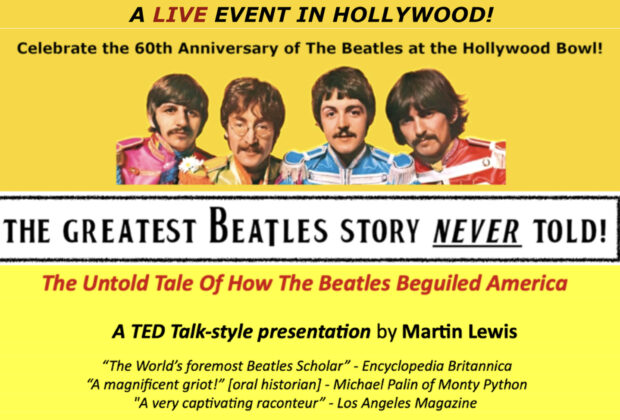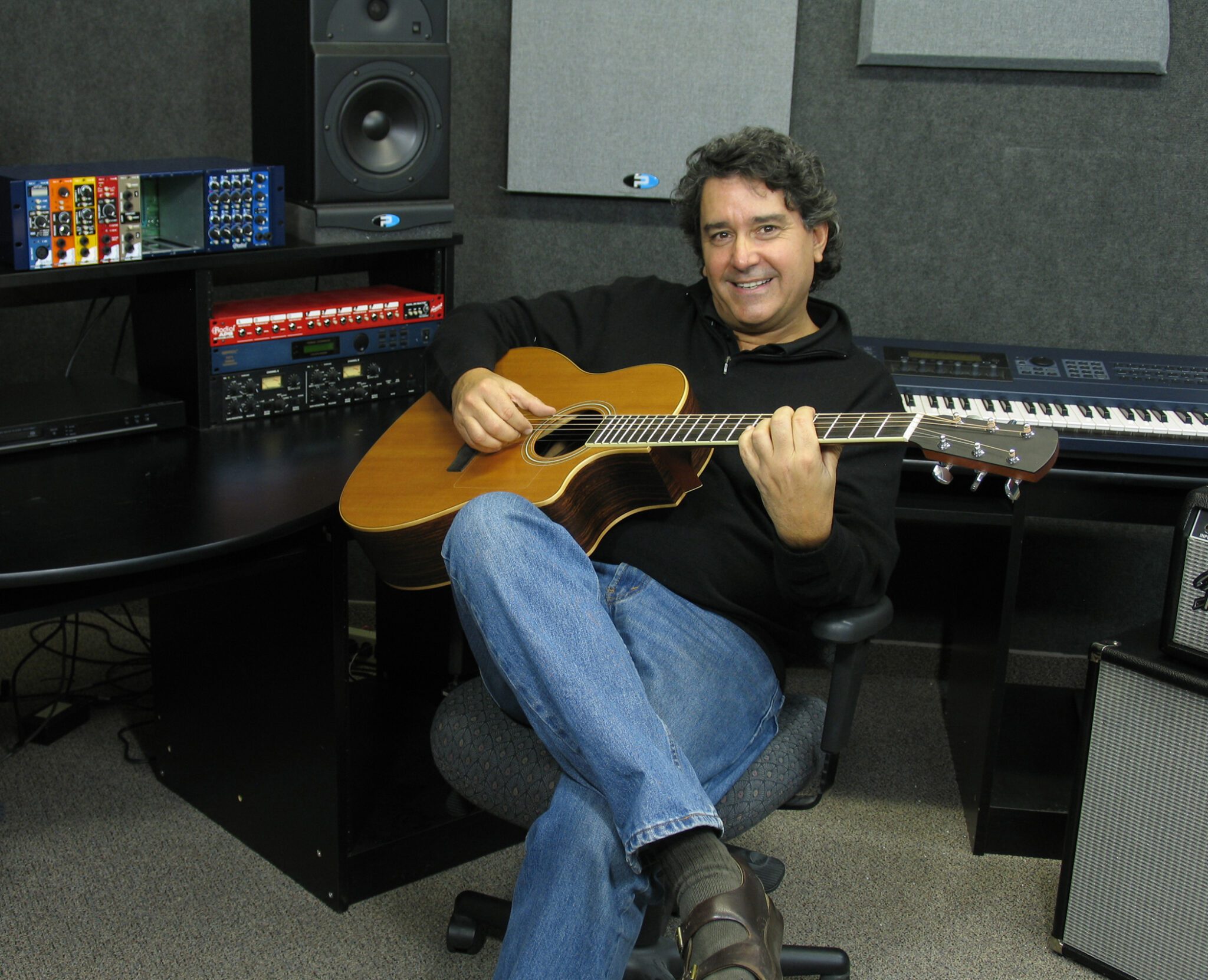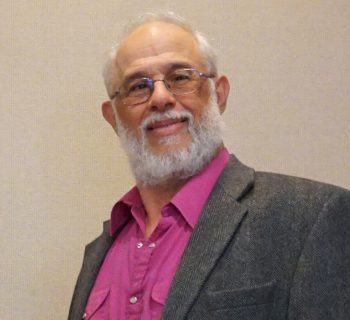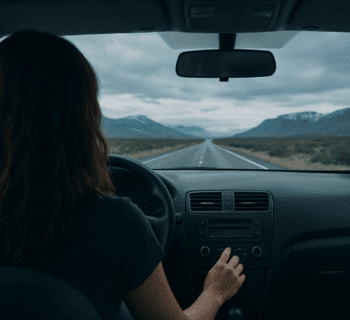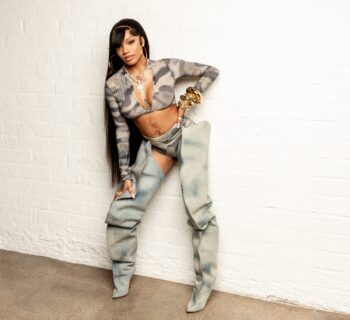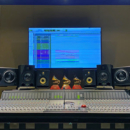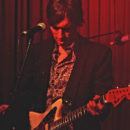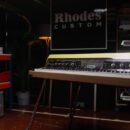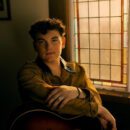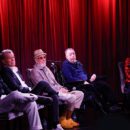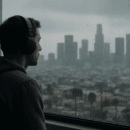It’s not a secret why the Beatles had an emotional, musical, physical, and spiritual relationship to Hollywood and Southern California. In the mid-seventies John Lennon moved to Los Angeles, liked it too much, and returned to New York to retire. Paul, George, and Ringo all purchased homes in Los Angeles County; George died in 2001 and cremated at Hollywood Forever Cemetery. His funeral was held in Pacific Palisades at the Self-Realization Fellowship Lake Shrine.
“I think Hollywood--the town and the industry--really set the stage for Beatlemania,” UCLA graduate, and novelist Daniel Weizmann suggested to me in a 2023 email correspondence, “by raising a generation on Anglophilic fun from Alice in Wonderland to Peter Pan to all the Hayley Mills classics. The daughter of actor Sir John Mills and novelist-playwright, Mary Hayley Bell, Hayley Mills was every local boy's British dream girl.
“Her big hit single ‘Let’s Get Together’ for The Parent Trap, written by Disney employees Robert and Richard Sherman, was cut on Sunset Boulevard with producer Tutti Camarata at his Sunset Sound Recorders.
“It's almost impossible to overstate how Anglophilic Hollywood was in those days--and not just on the big screen. From the faux Tudor architecture to actors wearing ascots to even the street names...I myself grew up on Ben Lomond Place--5,000 miles from the loch!
“It was a funny post-war exchange, this Angeleno /Anglo connection, parodied in Evelyn Waugh's The Loved One: An Anglo-American Tragedy. L.A. hungered for English sophistication, but the actual Brits who came here were seeking the new thing, sunburst electric innocence.
“European intellectuals like Reyner Banham, Christopher Isherwood, and Aldous Huxley travelled to the Far West as a way of escaping Western Civilization. They wanted to dig the future, in all its surf-crazy, open-hearted glory. The Beatles, raised not just on American R&B but also on Honey Pie's Hollywood Dreams, are the ne plus ultra of this exchange.
“They played the Hollywood Bowl on August 23, 1964 to roaring crowds. Exactly four days later, on August 27th, Mary Poppins--featuring classic songs like ‘Chim Chim Cher-ee’ also written by the uthan anybody could have predicted.
“A year later, at Walt's request, the Shermans wrote ‘It's a Small World.’"
A news release below on Martin Lewis’ August 23rd Beatles’ event touts the world premiere of an unheard track from the Sgt. Pepper sessions. The celebration will be held at L.A.’s Philosophical Research Society - just 4 miles from the Hollywood Bowl Friday August 23rd marks the exact 60th anniversary of the Beatles’ landmark first appearance in Los Angeles in 1964.
“Friday August 23rd 2024 – 7:30pm • Event Location: The Philosophical Research Society 3910 Los Feliz Boulevard, L.A. CA 90027 • Event Title: The Greatest Beatles Story NEVER Told! The Untold Tale Of How The Beatles Beguiled America • Tickets/Details: $10 http://www.prs.org.
“Their L.A. debut was a sold-out concert at the Hollywood Bowl. It was the first of the four concerts the Beatles gave in L.A. between 1964-1966.
“Celebrating that historic occasion Martin Lewis - considered one of the world’s foremost Beatles scholars by authorities such as the Encyclopedia Britannica - will be debuting a special ‘TED-Talk’ style illustrated presentation in L.A. - titled The Greatest Beatles Story NEVER Told! The Untold Tale Of How The Beatles Beguiled America
“The location is the architectural landmark headquarters in the Los Feliz area of Los Angeles of the Philosophical Research Society – the venerable nonprofit cultural institution founded in 1934.
“About The Philosophical Research Society: www.PRS.org The Philosophical Research Society is a repository of multicultural sources of wisdom and as a center of arts and learning. The Society presents a vibrant, year-round calendar of cultural events open to the general public. These include concerts, film screenings, theatrical events, dance recitals, poetry readings, author talks, lectures, seminars, gallery exhibits and performance art. The programs encompass and celebrate a wide range of disciplines and creativity including philosophy, mythology, mysticism, metaphysics and an eclectic array of the arts. The Society is headquartered in the Los Feliz neighborhood of L.A. in a site designated as an historical-cultural landmark by the city of Los Angeles
“During his Talk, Martin Lewis will reveal the fascinating untold tale of exactly how the Beatles went from total unknowns in the USA on Christmas Day 1963 (when 99.9% of the US population had never heard of them) to their spectacular US TV debut just 46 days later on The Ed Sullivan Show with a then recordbreaking 73 million Americans tuning in to see them. (The usual Sullivan audience in that era was just 14 million.) Which led to their riotous sold-out Hollywood Bowl concert just 6 months later.
“The story includes fascinating tangential details involving iconic American figures such as President John F. Kennedy, TV news anchors Walter Cronkite & Mike Wallace, TV hosts Ed Sullivan & Jack Paar, Oscar-nominated movie star Nancy Olson (Sunset Boulevard), the cartoon characters Sylvester the Cat & Tweety Bird, a 14-year-old schoolgirl from Silver Springs, Maryland and even Bozo The Clown! Martin Lewis’ expertise about the Fab Four includes very extensive credits across the Beatles universe - as a producer (the two-disc Deluxe DVD edition of A Hard Day’s Night, TV special ReMeet The Beatles etc etc), marketing strategist (Beatles Anthology, Beatles Live At The BBC, and projects for Paul McCartney & George Martin) and Beatles author (for Encyclopedia Britannica, Time, Variety, Salon, Huffington Post).
“The finale of the illustrated talk will include a notable first - likely to intrigue and excite Beatles fans. The World Premiere of a never-before-heard recording from the 1967 Sgt. Pepper sessions. The biggest under-sung hero of the Beatles’ extraordinary global breakthrough was their then 29- year-old manager Brian Epstein - who despite having zero entertainment industry experience - used his natural instincts and his passion for the Beatles to play high-stakes games of bluff with two of the biggest leaders of the US entertainment world. He beat them both and paved the way for the Beatles’ meteoric invasion of America.
“The creator/narrator of The Greatest Beatles Story NEVER Told! is a noted longtime champion of Epstein. Lewis - a protégé of famed Beatles publicist Derek Taylor - organized the first-ever reissue of Epstein’s 1964 autobiography, wrote the 25,000-word companion narrative and led the 16-year campaign that is widely credited with leading to Epstein’s belated induction as a non-performer into the Rock ’n’ Roll Hall of Fame in 2014. He instigated and runs the official Brian Epstein website. Epstein died of an accidental overdose of sleeping tablets on August 27th 1967 - age just 32.”
“Martin Lewis’ TED Talk-style event takes place on the 57th anniversary of Epstein’s last meeting with the Beatles. Tickets for the event cost $10.00.
“Full details and ticket purchase at www.PRS.org/Beatles.”
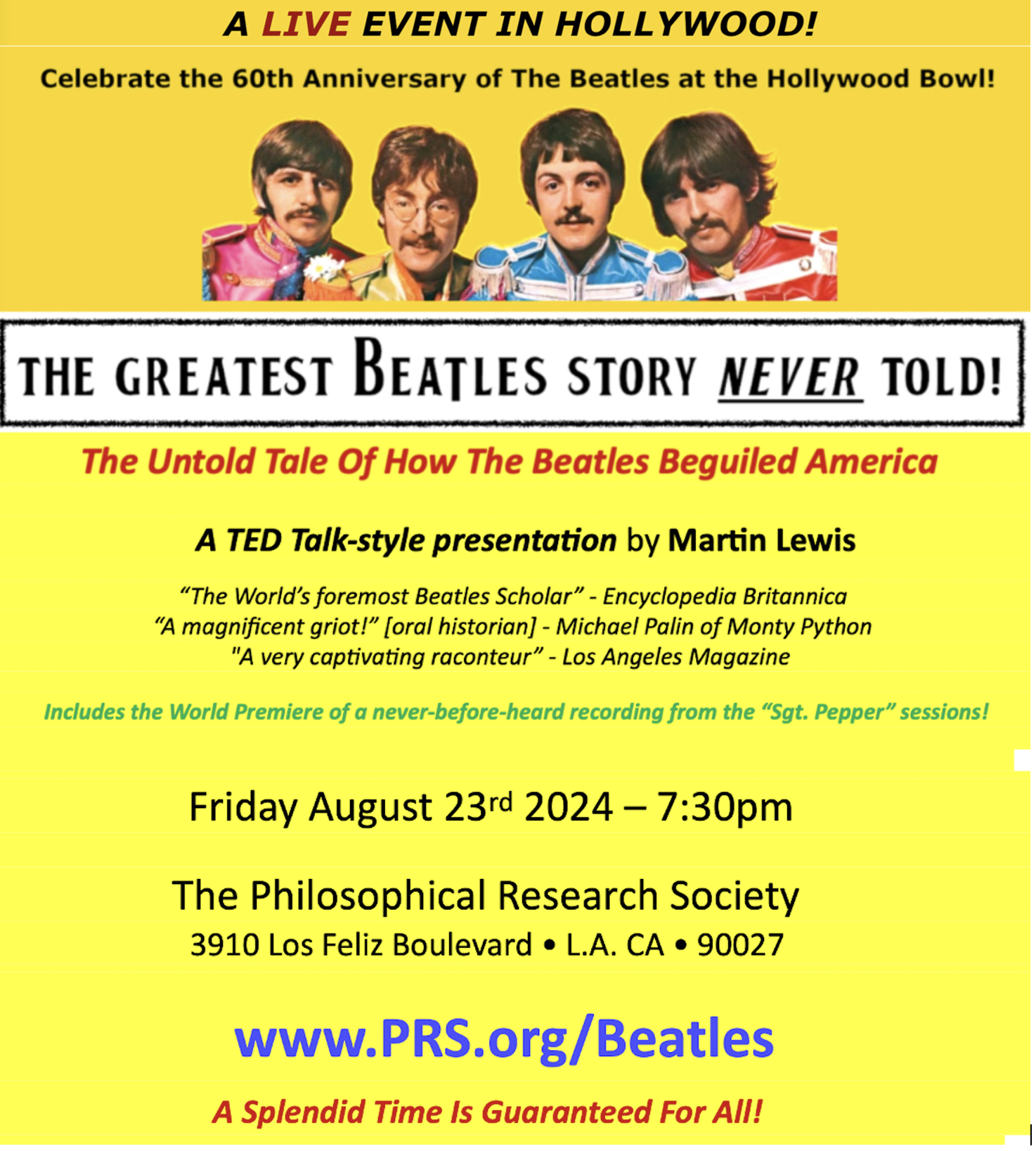
“Hollywood and the Beatles were the two greatest romances of the 20th century,” posed writer, poet and deejay Dr. James Cushing to me in a 2023 correspondence. “What did they have in common? How did they intersect? How did one of these great affairs learn from the other?”
Dr. Cushing, presented his theory to me why the Beatles became a transformative force and available to us in North America during February 1964.
“I begin with the poetic notion that the ritual reappearance of a Dionysian hero—young, sexy, full of vitality and signaling the return of spring—was key to the deeper meaning of JFK, and the reason so many people (women especially) loved him despite his political ineffectiveness as president.
“He had hair, he had erotic charisma, he had TV stardom and a great voice—and then, as it must with all Dionysus stories, tragedy struck. Author Don DeLillo wrote that Dallas ‘broke the back of the American Century.’ End of this Dionysus cycle? Apparently so...and then, seemingly out of nowhere (Liverpool?), on The Ed Sullivan Show, two months and two weeks after November 22, 1963, on the same TV that gave you JFK, we get—who could have predicted it?—four Dionysian heroes who wear the garb of the singer Orpheus!
“My God, the hand of fate traded Kennedy for the Beatles! And so, they blended Dionysian ecstatic energy with Orpheus’ romantic loyalty to Eurydice for an erotically unbeatable moment.
“It was a period post–Dwight Eisenhower and now post–John F. Kennedy. America was still in mourning for John F. Kennedy, and we were all still feeling freaked out about the Russians on a Bay of Pigs level. Plus, the whole question about civil rights and civil rights for Negroes were still a bunch of big issues.
“Everything on the news was challenging. Everything was tragic and everything was a bummer. And the postwar period had been primarily one of anxiety and conformity, with a few interesting rebels that stood out, like Allen Ginsberg and Elvis Presley.
“It was the reality that now we had something positive and enthusiastic. Something that gave a kind of grand permission to let all those bottled repressed feelings out. Here was permission to shake your hair, scream and go crazy. There was a sense of tremendous cool, positive energy, tremendous potential for excitement, tremendous permission. Everything about the joy of romance that can happen in public was happening there with the Beatles.
“The girls who went to the Ed Sullivan Theater or the Washington D.C. Coliseum or the Hollywood Bowl or Shea Stadium were not going to hear a concert of popular music but to worship an ancient hairy deity in its four-bodied form. Their screams are so loud because years of sexual frustration lie behind them. In looking at footage from this period, it’s the girls who are most compelling as they shatter into ecstasy while the boys smile and maintain Olympian cool,” posed James.
On November 5, 1963, immediately following the Beatles’ historic Royal Command Performance, Brian Epstein flew to New York with Billy J. Kramer in order to huddle with the all-important editor of 16 magazine, Gloria Stavers. On his visit to New York, Brian met twice with Ed Sullivan in order to negotiate appearances by the Beatles on The Ed Sullivan Show.
At first, Sullivan offered Epstein and the Beatles only a spot during one broadcast. Epstein, who had his strategic eye on the prize of TV exposure did not focus as most managers would do on the fees. He even offered to pay travel, lodging and expenses, after Sullivan first declined a headline date.
Then Epstein countered with a guarantee for two different headline appearances. Sullivan was rather surprised by Epstein’s firm demands. They settled on two principal shows on successive Sundays – live on February 9th in New York and live on February 16th in Miami. With a third performance to be taped in New York to be shown at a later date.
As it happens the third performance was taped on the afternoon of the first show (Feb 9th) and then aired on Sunday Feb 23rd. Meaning that the Beatles appeared on three successive Sundays – though that third airing date was not initially scheduled. It was after the first appearance that Sullivan realized that he could capitalize on his good fortune by airing that additional performance to make it three consecutive weeks of the Beatles.
Epstein then skillfully used the fact that he now had a commitment for three Sullivan TV spots to finalize an already in-discussion negotiation with Capitol Records president Alan Livingston for US releases of the Beatles. He got Capitol to commit to a vast promotional budget for his group.
Writer/producer Martin Lewis – who was a protégé of former Epstein assistant (and subsequently key Beatles publicist) Derek Taylor – instigated and ran the successful campaign to get Epstein into the Rock and Roll Hall.
“When I launched the campaign in 1998, I had a couple of meetings with Alan Livingston,” Lewis wrote in a December 2023 email.
“He told me that Brian Epstein had played a brilliant game of poker with him. Brian had phoned Livingston in mid-November 1963 – hustling to get Livingston to commit to releasing the Beatles in the US. His underlings at Capitol had already rejected the group on four occasions in 1963.
“When Livingston played coy and refused to commit - Epstein acted dumb. ‘I understand that TV is very important in your country. Would it help if I could get my Boys a slot on one of your American TV shows?’ Livingston said that it would. ‘What about a program which I think is called err… ‘Ed Sullivan’ – if I could get them on that show – would that help?”
“Livingston was convinced that the Englishman on the other end of the phone was a naïve loser. When Epstein said ‘well if I can get them an appearance on the Sullivan show – THEN will you commit to release my group in the US?’
“Livingston agreed. Then Epstein went for the kill. ‘And if I could get them THREE appearances on Sullivan – would you commit to a large promotional budget to launch them?’
“Certain he was dealing with a fantasist, Livingston readily agreed. What did he have to lose? A totally unknown manager representing a totally unknown British music act with strangely long hair and no US record deal - had no chance getting his act on the Sullivan show once – let alone three times.
“Livingston immediately gave his word and hung up.
“With his trap sprung Epstein waited a couple of days – so that he could create the illusion of having had sufficient time to negotiate such an improbable deal. Then he called Livingston and told him the Beatles had got a commitment for three Sullivan appearances!
“Livingston told me that at that point he was certain that Epstein was crazy. He said he’d have to call Epstein back. He then phoned Bob Precht the producer of the Sullivan show – certain that he’d be told that the show had never heard of the Beatles.
“To his astonishment he learned two things. Firstly, that the Beatles indeed had got a contract for three Sullivan appearances. And secondly – that the contract had been signed two weeks earlier! That Epstein had the signed contract in his back pocket when he first phoned Livingston and had asked if getting a US TV show might help him get a record deal!
“Livingston told me, ‘I realized immediately that I had been played. Out-played. Brian had bluffed me brilliantly. I wasn’t mad. I was thrilled. If this guy was that skillful and that passionate about out-smarting me. If he was that skillful and that passionate to get Sullivan to commit to showcasing his group on three shows – I knew I was dealing with a promotional genius. I’d already given my word for a generous deal if Brian delivered. And as he had delivered, I committed to the deal for the Beatles on that phone call. I wasn’t sure yet about the Beatles. But I WAS getting in business with the guy who was sure…’”
Martin Lewis summarized the paradigm shift that occurred in February 1964:
“The Sullivan show at that time is still in black & white. Sullivan wasn't transmitted in color until September 1965. But watching video of the 1964 show tells the whole story. The studio audience members are in black & white. In fact, they appear to be shrouded in Eisenhower gray. It’s still the 1950s in America. But by comparison the Beatles appear to be in 3-D Technicolor. It’s already the 1960s in their Fab bubble. America is about to be dragged into the future by four lads from a galaxy far, far away. The British Empire is striking back…"
Heather Harris, is a graduate of the Westlake School for Girls and UCLA. A music photographer, photojournalist and commercial artist who once worked in the publishing division of A&M Records, she attended the Beatles’ 1964 and ’65 Hollywood Bowl concerts and their ’66 Dodger Stadium show in Los Angeles. In December 2023, Heather emailed her memories when the Beatles came to play in Hollywood.
“Teenaged and/or pre-teenaged recherche du temps perdu remain notoriously inaccurate, ruled as they are by hormonal, passionate emotions rather than staunch objectivity. However, this former pre-teen well recalls the first Beatles concert at the Hollywood Bowl, oasis of wondrousness observed in an otherwise dire pre-adolescence.
“I was a powerless pre-teen, landlocked in my passions for doing visual art and following music by a familial regime bent on churning out clones of socialite, debutante, non-vocational mommy-track forebears devoid of outside purpose. Listening to my transistor radio under the pillows in bed at night, I heard ‘I Want to Hold Your Hand’ (the first widespread US Beatles release) and the earth shifted on its axis for me.
“It’s said that universal pop music introduces pre-adolescent females to the opposite sex by offering slightly gender-neutral totems of directed passion, not too scary or overtly sexual, from Avalon to Cassidy to Bieber. In the case of the Beatles, this is hogwash. No matter how thoroughly Brian Epstein cleaned them up, the bad boys came through, much as the syndrome had with early Elvis Presley despite his Colonel.
“As with early-’60s European nouvelle vague movie stars, the Beatles’ outsider long hair signified danger and a new generation’s look. The self-written, self-performed, harder rock music also denoted a demographic sea change of non-formulaic, uncontrolled talents, which spilled over into all the arts. And those witty press conferences, with Lennon & Co.’s ad libs, added just the right frisson of intellectualism to rope in smart teens.
“Overall assessment: every young female I knew, from honor students to proto-slackers, wanted to fuck a Beatle. (And some actually did. But that’s another tale.) I even made pocket change drawing fellow student/clients en flagrante with their favorite Beatle or Rolling Stone.
“However, as a powerless pre-teen, scalper ticket prices were not at my avail, plus the 1964 Hollywood Bowl appearance sold out within hours the same day, an impossible barrier to pre-Internet, non-driving pre-teens. (Los Angeles then as now has no really reliable public transportation.)
“I desperately prevailed upon every entertainment biz contact in my purview, which meant fellow classmates’ parents. My own parents were virulently anti-showbiz, since my former singer father had quit with an ‘If I can’t, nobody in this family can!’ obstructionism (to last all my life).
“Last resort: my parents’ friends at their church. Where I struck gold. One of their church chums was Randy Wood, president of Dot Records and Ranwood Records (sample artists: Ivory Joe Hunter, Pat Boone, the Del-Vikings, Arthur Alexander, Jimmy Gilmer & the Fireballs—pals of Buddy Holly with a giant hit record ‘Sugar Shack’), which had distribution ties to Vee-Jay Records, which, unbeknownst to most all but completionist record collectors, was the Beatles’ first record label in America until Capitol Records sorted out their domestic ownership of them via EMI.
“Randy told me to not count on it, and kindly gave me the consolation prize of a Beatles’ interview 45 record. This was a promo item with dead air time for whatever DJ at whatever radio station to ask the Beatles questions, then the pre-recorded Beatles provided answers afterwards. This gift engendered a great introduction to the real world of the music business at a tender age! Then he came through with a single ticket.
“Much negotiation to get parents to drop off and pick up. Reward: 35 minutes of audience hysteria and itty-bitty Beatles! But no complaints. One could see they did play their own plugged-in instruments, even if one could barely hear same or any vocals whatsoever. In-person vindication! (Answer to unspoken question: even the teens I knew with good cameras and telephoto lenses got terrible pics, given the huge distance betwixt audience and band. With my then crap equipment I didn’t even bother.)
“I attended the next year’s Hollywood Bowl and following year’s Dodger Stadium shows as well, the last one with teen musician guy friends who tried to document same on one of the era’s giant reel-to-reel tape recorders.
“I was dragooned into smuggling the enormous interloping machine in my typical girl’s beach bag. The straw-woven bag burst under the weight and spilt one reel of tape unspooling down an entire bleacher stairs in the stadium, top to bottom. Tape undamaged, hasty retrenching and re-spooling unseen by the long arms of the law. Of course, all my guy friends got was the din of audience screaming…”
“Beatles music of course underscored my determination to work my visual magics in service to the business of music, and I changed my name to something easier to remember once I started getting published nationally at age 18.
“I then experienced and documented one of the most creative fertile explosions of art of all time, photographing as many of the greats who came through my native Los Angeles as I could for the next half century. In retrospect, what I failed to realize back in 1964 was how fucking good those Beatles were for being that young. We all were young, and our youth was shared cloak of invisibility at the time.”
Harvey Kubernik met the four Beatles and over the years conducted interviews with three of the members last century.
Kubernik is the author of 20 books, including 2009’s Canyon Of Dreams: The Magic And The Music Of Laurel Canyon, 2014’s Turn Up The Radio! Rock, Pop and Roll In Los Angeles 1956-1972, 2015's Every Body Knows: Leonard Cohen, 2016's Heart of Gold Neil Young and 2017's 1967: A Complete Rock Music History of the Summer of Love.
Sterling/Barnes and Noble in 2018 published Harvey and Kenneth Kubernik’s The Story Of The Band: From Big Pink To The Last Waltz. In2021 the duo wrote Jimi Hendrix: Voodoo Child for Sterling/Barnes and Noble.
Otherworld Cottage Industries in 2020 published Harvey’s Docs That Rock, Music That Matters.
He is currently writing a book Screen Gems: (Pop Music Documentaries and Rock ‘n’ Roll Television Moments).
Kubernik is in several book anthologies, most notably, The Rolling Stone Book Of The Beats and Drinking With Bukowski. Harvey wrote the liner notes to CD re-releases of Carole King’s Tapestry, The Essential Carole King, Allen Ginsberg’s Kaddish, Elvis Presley The ’68 Comeback Special, The Ramones’ End of the Century and Big Brother & the Holding Company Captured Live at The Monterey International Pop Festival.
During 2006 Harvey spoke at the special hearings initiated by The Library of Congress held in Hollywood, California, discussing archiving practices and audiotape preservation. In 2017 Kubernik appeared at the Rock and Roll Hall of Fame in Cleveland, Ohio, in their Distinguished Speakers Series.

